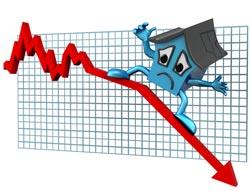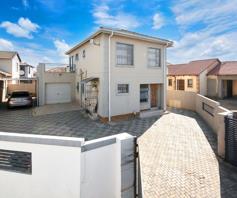Whether or not you believe the South African housing market is 25 percent overvalued, expect some further real house price decline.

Meanwhile, the FNB January House Price Index Report has revealed that while it is difficult to estimate by how much the residential market is overvalued, the bank is of the opinion that 2012 will bring about a further real house price decline.
Following the Rode Report that revealed that house prices are overvalued by 25 percent, FNB says it cannot contradict the statement and believes that it is not possible to say.
Last week, the report stated that real house prices are still 25 percent more expensive than is suggested by their trend line of the past 44 years.
Click here to read the article.
When news of house prices being 25 percent overvalued appeared, estate agents came out fuming, saying Rode’s prediction was off the mark.
The estate agents felt they needed to challenge Rode as they felt strongly this was not the real case from where they are sitting.
Rudi Botha, chief executive officer of BetterBond, says for this to happen there would either have to be a very large differential between nominal house price growth and the rate of inflation for the next few years or a very long period of no real growth, neither of which seems likely at this time.
Lew Geffen, chairman of Sotheby’s International Realty in South Africa says it is difficult to see how Rode came to that prediction given what is actually happening in the current market.
Geffen notes that banks continue to relax their lending criteria and are currently reducing their deposit requirements and granting more 100 percent loans as well as more loans overall.
He explains that they do not believe banks would be doing this if they were concerned that home values were going to show a further serious decline.
Geffen says they believe that with nominal prices and rates at their current historic lows, there could hardly be a more propitious time for potential buyers to enter the market.
Samuel Seef, chairman of Seeff Properties, says Rode’s views are one-dimensional and sends the wrong message to the ordinary buyer.
Seeff says in contrast to the commercial market, the residential market is driven by emotional needs.
“About 95 percent of buyers are not looking for investment returns or rental income, they want foundation upon which to build a life.”
He says these are ordinary buyers looking to acquire their first home, expand or move closer to schools or jobs and they cannot put their life on hold.
As such, he says no value can be put on owning the roof over your head because it is an investment in your own future and stability.
Seeff’s view is that with interest rates at a 30-year low and mortgages more affordable than ever, market conditions are heavily weighted in favour of buyers.
Meanwhile, the FNB January House Price Index Report has revealed that while it is difficult to estimate by how much the residential market is overvalued, the bank is of the opinion that 2012 will bring about a further real house price decline.
FNB says this is based on the bank’s economic expectations and how far the real house price decline will go in the current period of stagnation will depend on the world’s and South Africa’s ability to turn things around and get back to a respectable longer term economic growth path in the coming years.
Writing in the report, FNB Home Loans property strategist John Loos says with regards to the Rode Report, they interpret the 25 percent overvalue to mean that it would require a very significant decline in house prices in real terms in order to get back to what Rode deems to be an appropriately priced market that would be in balance or equilibrium.
Loos reckons that people may have over reacted following the report as Rode is not predicting a sudden downward price correction but expects a gradual real price decline over some years.
FNB says it would be extremely difficult to ascertain by how much the market is over-valued or unrealistically price and that in any case, the equilibrium price level (if one could determine it) is very much a moving target, fluctuating frequently as economic fundamentals change.
Loos says the Rode methodology is a technical analysis as opposed to a fundamental analysis. A long-term real house price time series is calculated using average house prices and average building costs.
The rationale behind using building costs with which to adjust house prices in real terms has to do with the view that building costs drive property values over the long term.
Assuming that supply of new homes can be added by developers with no constraints to supply due to urban planning requirements or land availability, then building costs determine house prices in the long term.

Assuming that supply of new homes can be added by developers with no constraints to supply due to urban planning requirements or land availability, then building costs determine house prices in the long term.
If existing house prices were above building costs, supply of newly-built homes would increase bringing house prices back down in line with building costs.
He says if existing house prices move too far below building costs the new supply would slow until the demand-supply balance had been restored and house prices moved higher and closer to building costs.
Loos explains that according to the theory as they understand it, real house prices, as calculated through deflating nominal house prices with building costs, should move in the broad sideways band over the long term.
“If the real price level is significantly above the long term trend line, as is currently the case when using 1966 as a starting point, the theory is that the market is overvalued and the current Rode estimate that it is overvalued by 25 percent.”
However, Loos points out that the bank has some reservations about using this methodology.
While the theory could work under the assumption of totally elastic supply of new homes as required by the market, we are no longer convinced that such elasticity is a reality in South Africa any more.
He says Cape Town has a relative land scarcity for property development, which keeps its average property values above those of Johannesburg in spite of this city having higher average per capita income.
“We believe it conceivable over the long term that real house prices can increase significantly and that South African cities can and will become far more expensive places to live in.”
Loos says when using long term trend lines to determine whether a market is under or over-valued, one can literally pick starting points to prove whatever theory they wish.
He says when one starts in 1966 as Rode does, real house prices are indeed above the long-term trend.
In 1995 one could state according to this theory that the market is undervalued.
The third and final consideration with regard to using a long-term real average house price trend is that the average house price of the mid-1960s is different to the average house of today.
“Real property values have risen significantly since the mid-1960s but will not necessarily wholly be seen in an index depicting the average house price.”
The market does not only adjust to real house price surges through a subsequent downward correction in real prices.
Real per square metre existing property values can remain permanently higher if land scarcity remains permanently higher, with developers providing smaller homes on smaller stands.
Over the past decade, full title homes valued by FNB and built between 1970 to 1974 had average stand sizes of 1 063 square metres.

Percentage of homes with swimming pools had declined from 40.3 percent of those built between 1975 to 1979 to 7.3 percent by 2010+.
Homes built from 2010 to date had seen their average stand size almost halve to 557 square metres.
Over the same period, the average size of a home built had dropped from 203 square metres to 150 square metres and 69.3 percent of homes built from 1980 to 1984 had garages, this had declined to 53 percent by 2010.
Percentage of homes with swimming pools had declined from 40.3 percent of those built between 1975 to 1979 to 7.3 percent by 2010+.
Loos says when analysing real house prices since 1966, one could conclude that the long-term real price trend line from that point is more or less flat or has very little rise over time.
He says if we could calculate a price index that adjusted for declining stand size/home size and level of luxuries, we would see more of a rising long-term real price trend line.
“This is because over the long term, as urban land becomes increasingly scarce, real prices are rising.”
Loos says the real values are staying permanently higher over the very long term and the development sector is adjusting by providing smaller and less luxurious homes with time.
The FNB House Price Index showed a slight acceleration growth of rate of 5.6 percent year-on-year (y/y) in January 2012 from 4.7 percent in December 2011.
Loos says this is the highest y/y growth since August 2010.
In real terms, this growth rate implies that real house price decline continues.
Consumer price inflation for December was around 6.1 percent and a 4.7 percent house price growth rate in that month translates into about -1.4 percent real decline.
“This means that in real terms, the latest revised figures put the average house price in real terms at -15.5 percent lower than the peak of February 2008.”
He adds that the bank feels that the market is unbalanced and that their indicators of demand versus supply still point to an unrealistically priced market. – Denise Mhlanga







